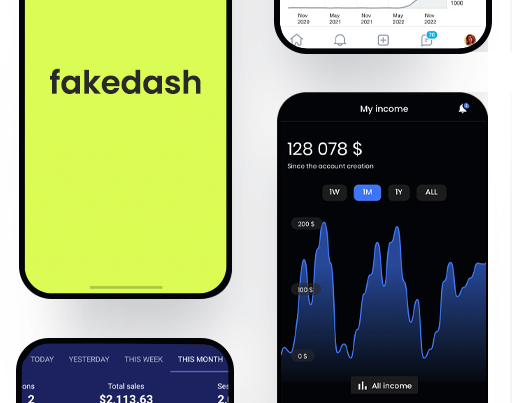
When it comes to selling e-commerce courses, one of the biggest challenges is convincing potential students of the value and effectiveness of your program. People want to see results before they invest in any training. That’s where a Fake Shopify Dashboard comes into play—a powerful tool that can make it much easier to sell courses, engage students, and even help them land big brand deals after they’ve completed the training.
How a Fake Shopify Dashboard Simplifies Selling Courses
- Creating a Compelling Visual Aid : When selling e-commerce courses, showcasing results is key to building trust and credibility. A fake Shopify dashboard filled with impressive metrics can serve as a powerful visual aid during sales calls, webinars, or landing pages. By displaying a dashboard that mimics a successful store’s performance, you can help potential students see the potential impact of your course, making it easier for them to visualize what success could look like.This type of visual evidence can help overcome the hesitation that many potential students feel when investing in e-commerce training. The ability to present a “success story” through a simulated dashboard brings the concepts to life, making it more than just theoretical learning.
- Demonstrating Realistic Scenarios in Course Content : Incorporating a fake Shopify dashboard into the course content itself adds another layer of value for students. By using simulated data that mimics real-world scenarios, you can teach students how to analyze sales trends, optimize conversion rates, and understand key performance indicators without them needing an actual store. This hands-on approach not only enhances learning but also reinforces the notion that they’re acquiring practical skills that can be applied immediately in their e-commerce journey.
- Boosting Confidence During Sales Calls : When trying to sell courses to potential students, confidence and presentation make all the difference. A fake Shopify dashboard allows you to show results, even if you or your previous students don’t have live data to share. During sales calls, you can walk prospects through what a thriving Shopify store could look like, helping them understand the kind of growth they can achieve. By using a simulated dashboard, you present the potential in a concrete and understandable way, significantly increasing the likelihood of converting prospects into paying students.
How Students Use the Fake Shopify Dashboard to Close Big Brand Deals
Once students have completed the course, the utility of the fake Shopify dashboard doesn’t end there. It can become a valuable asset for those aiming to work as e-commerce consultants, digital marketers, or even launch their own agencies. Here’s how:
- Impressing Clients with a Portfolio : For many students who complete e-commerce courses, the next step is to use the skills they’ve learned to pitch services to big brands. Having a realistic-looking Shopify dashboard in their portfolio can make all the difference in impressing potential clients. When approaching brands, students can showcase the simulated dashboard as an example of the type of store performance they understand and could help replicate.While transparency is essential, and students should disclose that the dashboard is simulated, it still serves as a valuable demonstration of their knowledge, skills, and the e-commerce principles they’ve mastered. This approach helps bridge the gap between learning and real-world application, giving students a portfolio piece that stands out.
- Using the Dashboard as a Case Study Example : When pitching big brands, having a fake Shopify dashboard allows students to present a detailed case study—even if it’s based on simulated data. They can walk potential clients through the strategies they would use to grow a store, using the dashboard to explain how various metrics could be optimized for better performance. This demonstration of insight and understanding helps build trust, making it easier to close deals with larger companies that might be looking for consultants or marketing experts to scale their e-commerce efforts.
- Presenting During High-Stakes Meetings : When students are trying to close big deals, especially with well-known brands, the pressure is on to prove that they know what they’re talking about. A fake Shopify dashboard gives them an edge by allowing them to illustrate their points with data-driven examples. It provides a reference point for discussing key metrics, potential growth, and strategy implementation, which can be pivotal in sealing the deal.The visual appeal of the dashboard, paired with the student’s understanding of how to drive success in an e-commerce store, helps create a compelling case for why they are the right person for the job.
The Bottom Line
Using a Fake Shopify Dashboard doesn’t have to be about deception; rather, it can be a strategic tool for effectively selling e-commerce courses and setting students up for future success. By using a simulated dashboard, course sellers can demonstrate the potential of running a Shopify store, making it easier to engage prospects and close sales.
For students, the benefits extend beyond the classroom. With a fake Shopify dashboard, they can confidently approach big brands, demonstrate their e-commerce knowledge, and pitch their services with a visual edge that can be the difference between landing a deal or not. When used transparently and ethically, a fake Shopify dashboard becomes a valuable tool in the journey from learning to real-world application, making it a win-win for course sellers and students alike.




